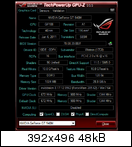3dc_member
New Member
- Joined
- Mar 31, 2010
- Messages
- 15 (0.00/day)
The pixel fillrate in GPU-Z is displayed wrong for Nvidia Fermi based graphics cards. The pixel fillrate seems to be calculated by multiplying the number of ROPs and the GPU clock. But in case of Fermi gpus the pixel fillrate is generally not limited by the number of ROPs but by the number of streaming multiprocessors. Each streaming multiprocessor is capable of processing two pixels per clock. So if there are 16 SMs and 48 ROPs like in the GeForce GTX 580, the SMs limit the pixel fillrate. This is the case for all Fermi based graphics cards i know.
Having more ROPs than pixels that can be processed per clock help to sustain a high pixel fillrate when using multiple samples per pixel (i.e. multisampling antialiasing) but the peak pixel fillrate is limited by the stream processors.
Check out these benchmarks by hardware.fr (scroll down to section 'Fillrate'): http://www.hardware.fr/articles/806-4/nvidia-geforce-gtx-580-sli.html.
The measured peak pixel fillrate of the GeForce GTX 580 is 23,3 GPixel/s. Simply multiplying the 48 ROPs with the 772 MHz gpu clock would give you a peak pixel fillrate of 37,1 GPixel/s. But as the pixel fillrate is limited by the streaming multiprocessors, the peak fillrate is only 16*2*772 MPixel/s = 24,7 GPixel/s. This number corresponds well to the measurement taken by hardware.fr.
If you look at non fermi graphics cards you will see that the measured peak pixel fillrate corresponds well to the product of number of ROPs and gpu clock.
Many reviews cite the wrong peak pixel fillrate for Fermi cards and Nvidia doesn't publish pixel fillrate numbers on the product pages. But knowing the Fermi architectural properties you can easily calculate the right peak pixel fillrate. I hope that GPU-Z will be fixed in a way to show the right peak pixel fillrate on Nvidia Fermi graphics cards.
Having more ROPs than pixels that can be processed per clock help to sustain a high pixel fillrate when using multiple samples per pixel (i.e. multisampling antialiasing) but the peak pixel fillrate is limited by the stream processors.
Check out these benchmarks by hardware.fr (scroll down to section 'Fillrate'): http://www.hardware.fr/articles/806-4/nvidia-geforce-gtx-580-sli.html.
The measured peak pixel fillrate of the GeForce GTX 580 is 23,3 GPixel/s. Simply multiplying the 48 ROPs with the 772 MHz gpu clock would give you a peak pixel fillrate of 37,1 GPixel/s. But as the pixel fillrate is limited by the streaming multiprocessors, the peak fillrate is only 16*2*772 MPixel/s = 24,7 GPixel/s. This number corresponds well to the measurement taken by hardware.fr.
If you look at non fermi graphics cards you will see that the measured peak pixel fillrate corresponds well to the product of number of ROPs and gpu clock.
Many reviews cite the wrong peak pixel fillrate for Fermi cards and Nvidia doesn't publish pixel fillrate numbers on the product pages. But knowing the Fermi architectural properties you can easily calculate the right peak pixel fillrate. I hope that GPU-Z will be fixed in a way to show the right peak pixel fillrate on Nvidia Fermi graphics cards.



 the vga test system has a shortcut to the latest debug build on my work pc. so when i took those screenshots it used that build.
the vga test system has a shortcut to the latest debug build on my work pc. so when i took those screenshots it used that build.
